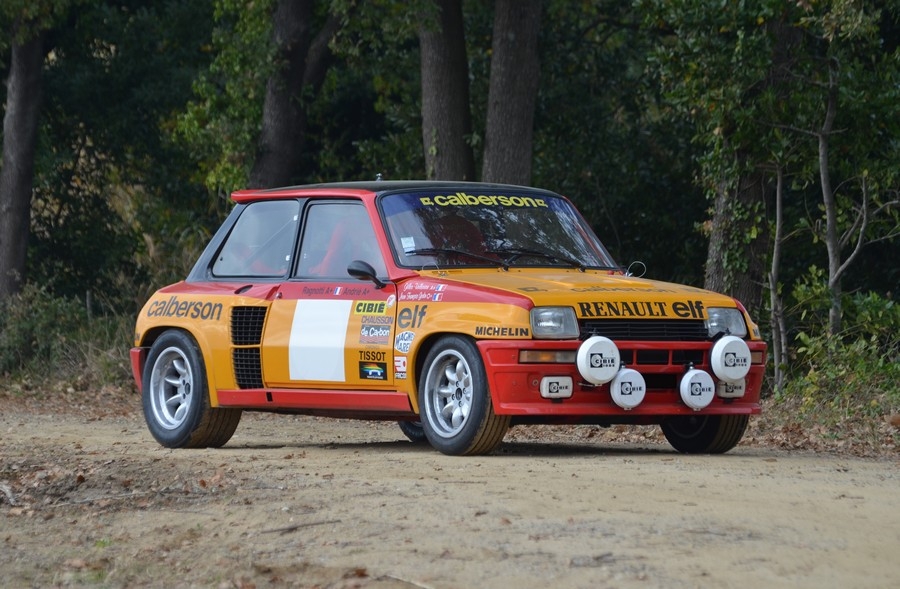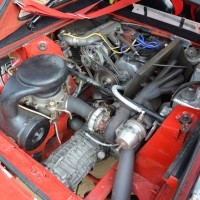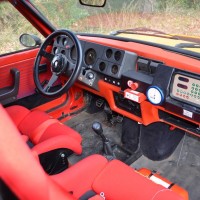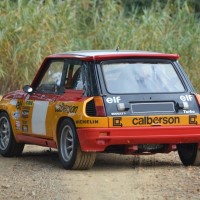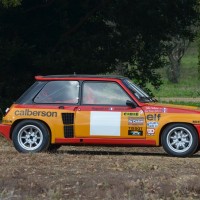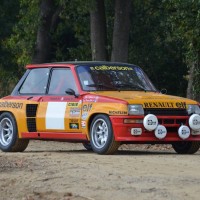In 1979, the modest Renault Sport division, responsible for the R5 Turbo rally program led by engineers François Bernard and Michel Têtu, only had the Group 5 prototype that had appeared on the Tour of Italy, the famous “Black” R5, assembled from specific Renault and Alpine parts.
Gérard Larrousse and his team had to wait for 400 examples of the production series to be built for homologation in Group 4 that would allow the R5 Turbo to compete in major international competitions. This was done before the summer of 1980. And so the car presented here was born, bearing the chassis number B000036 and registered 126 TZ 91 on September 8, 1980. This was the first R5 Turbo to be homologated in Group 4, and as a racing car, its exceptionally well-conserved condition is nothing short of a miracle.
“Coco” Prié, the mechanic well-known for his time at Alpine during the successful 1973 world championship era, and who moved to Renault as head of the rally support team, remembers assembling this R5 Turbo not at Viry Châtillon but at the F1 department at Antony, alongside Prost’s single-seater. The 1,400-cc turbocharged engine of this car was therefore prepared by the F1 workshop, and is the one and only R5T engine to have benefited from this treatment, as the others were built first at Viry and later by the Bozian brothers near Lyon.
The first campaign for B000036 was the famous Tour de France Automobile in 1980, which took place at the end of September. The car was given to factory driver Jean Ragnotti, with co-driver Jean Marc Andrié. The Ragnotti-R5T tandem caused great excitement and did not disappoint the spectators. Andrié declared, “The mechanics presented us with a magnificent car — the best-looking rally car I’ve ever seen.” It must be said that Coco Prié’s team worked through the night before the start to get the car ready. The rally unfurled in an atmosphere of excitement, marked by a scratch win for the R5 on the first special stage. The R5T B000036 went on to win six of the following special stages.
Unfortunately, the R5T’s first outing didn’t end in victory. An off-road excursion in the Col de Perty lost them five minutes, and they were forced to retire six stages before the end with an ignition problem. However, the R5 Calberson had won over a lot of fans and made a big impression. The spectators knew that a victory wasn’t far away.
B000036 and Jean Ragnotti were eagerly anticipated at the next event: the Tour de Corse. This splendid trial attracted the biggest names: Andruet, Thérier, Darniche, Frequelin, Rohrl, Ragnotti, Saby, Mouton ….
Jean Ragnotti was the clear favorite given the Tour Auto results. The team engineer Philippe Chasselut had worked to reduce the turbo’s response time and the R5 was the overall winner of the first four stages. A puncture on the following stage relegated them to 4th place, but they quickly regained the lead in front of Darniche and his Fiat 131 Abarth. The second section played into the Renault driver’s hands, thanks to the terrible weather. In Castagniccia, Ragnotti’s talent, together with the R5T’s good handling in the wet conditions despite the power of the turbo, increased his lead. However, just before the Col Saint-Roch, the alternator belt broke and the car stopped. It meant a retirement even though the event had effectively been won, and it was a huge disappointment for the team.
This Renault 5 Turbo is in exceptionally original condition for a car that has raced at this level. It is in the period Calberson livery, and has retained its running gear, which can be checked against the substantial photo album from the Tour de France Auto and Tour de Corse (Renault Sport 4 piston calipers replaced the two rear pistons). Mechanically, the car remains strictly original, with its large and specific Tour de Corse-type turbo. It still has its rare magnesium Minilite wheels, and the interior also retains a period feel, with the original carpets, and the rare onboard computer.
A close look at period photos show that the smallest details down to the bonnet catches have been kept. This car created a sensation at the last Tour de Corse Historique, being highly original among so many re-creations of period cars. It is certainly one of the most important R5 Turbo factory cars. Although not a race winner, it is the one and only R5 Group 4 car in Calberson colors.
B000036 is a spectacular, high-performance car, with a beauty that takes the breath away. It made its mark in rallies during the 1980s, setting new standards in major competitions, and took part in two of the most prestigious events for historic cars: the Tour de France Auto and the Tour de Corse. This is a truly exceptional car, eligible for all VHC events, and it has a Passport Technique National. This is a genuine competition car and not a modern replica.
The car has been signed by Jean Ragnotti on the bonnet, and its authenticity has been recognized by figures involved at the time including the famous “Coco” Prié, who was present on the Tour de Corse Historique.
SCM Analysis
Detailing
| Vehicle: | 1980 Renault 5 Turbo Group 4 |
| Number Produced: | 400 |
| Original List Price: | N/A |
| Tune Up Cost: | $200 |
| Distributor Caps: | $18 |
| Chassis Number Location: | Renault Turbo Owners Club, Renault 5 Turbo Facebook Group |
| Website: | http://www.rtoc.org |
| Investment Grade: | A |
This car, Lot 424, sold for $542,037, including buyer’s premium, at Artcurial’s Rétromobile auction in Paris, France, on February 7, 2014.
One challenge to buying an ex-competition car is figuring out whether the car is going to be roadworthy — or better left as a museum piece. Frederico Kroymans’ legendary mishap at the 2004 Monterey Historic Races is instructive.
Kroymans spun and took a light hit to the front of an ex-Works 1993 Ferrari F399 Formula One car. The impact broke the monocoque in half. Reliable information is scant about the history of this car, but it clearly was not fit to be on course at speed.
The situation with rally cars is even more risky. Rally cars routinely take a beating that track cars rarely suffer, and many rally cars are retired when the chassis is simply worn out. Even the best FIA world rally cars are still built on production chassis, and all those great pictures of flying rally cars come at a price.
All this is what makes this particular rally car such a smart buy. A careful read-through of its résumé shows verifiable competition use — but not too much. The car appears to have been rallied only on tarmac, saving it the abuse of unpaved roads and jumps. Plus, its tarmac career was mercifully short and devoid of reported crashes. The car’s short history was heavy on glory — even though it never won any rallies — and it appears to be straight, clean, and almost original to its Group 4 specifications.
Not your ordinary Le Car
Group 4 cars were defined by FIA as “Special Grand Touring Cars” until the group was replaced with the legendary Group B cars in 1983. A minimum production run of 400 cars over 24 months was required before a model could be homologated into the group. Renault achieved this early in the production run of the R5 Turbo – using lightweight aluminum doors, roof and tailgate to build the first 400, then switching to more prosaic steel components for the R5 Turbo 2 that made up the balance of the 3,576-unit production run.
The R5 Turbo differs from a standard Renault 5 (aka “Le Car” in America) in almost every way except the basic box design. Where the R5 is a low-powered front-wheel-drive economy car, the R5 Turbo is a mid-engine, rear-wheel-drive handful.
It’s not clear which version of the R5 Turbo engine currently resides in this car, but it’s a safe bet that it’s not the 350-horsepower version that was used in the R5 Maxi Turbo driven by Jean Ragnotti in 1985. The listing states that the car is as it was raced in the Tour de Corse, which would put the output closer to 207 horsepower — which is still plenty for a car over 30 years old running in Historic Rally!
The small items that are not original to the car’s professional competition history are to be expected. A turbocharger boost gauge is a smart add-on for a vintage racer, and the upgraded rear roll structure components are likely required for vintage racing, and shouldn’t affect the value of the car.
Huge money for history and fun
Which brings us to what the car brought at auction — a stunning $542,037 in Paris. The only comparable auction in the SCM Platinum Auction Database was in 2002 for an ex-Group B car (SCM# 29314) that failed to sell with a high bid of $12,610. Another Group 4 R5 Turbo (SCM# 206582) failed to sell at Bonhams in 2012. So, comparable values are difficult to assess — yet it seems this buyer knew what he was doing.
This car comes with a verifiably glorious racing history and without obvious flaws, and is ready to compete in Europe’s active Historic Rally series. The price paid sets a new high-water mark for these cars. I’d call this one fairly bought and well sold. ♦
(Introductory description courtesy of Artcurial Motorcars.)
